Managing People in an Organisation: Recruitment, Training, Motivation
VerifiedAdded on 2021/02/19
|12
|3768
|40
Report
AI Summary
This report provides a comprehensive analysis of managing people within an organization, using TESCO as a case study. It delves into the recruitment and selection process, emphasizing job advertisements, descriptions, and specifications. The report explores the importance of induction and training programs, highlighting the challenges and solutions associated with them. Furthermore, it examines various motivation theories relevant to organizations, such as Maslow's Hierarchy of Needs, and discusses factors influencing individual behavior. The report concludes with recommendations for improving recruitment and selection processes and overcoming training challenges, offering valuable insights for effective people management strategies.
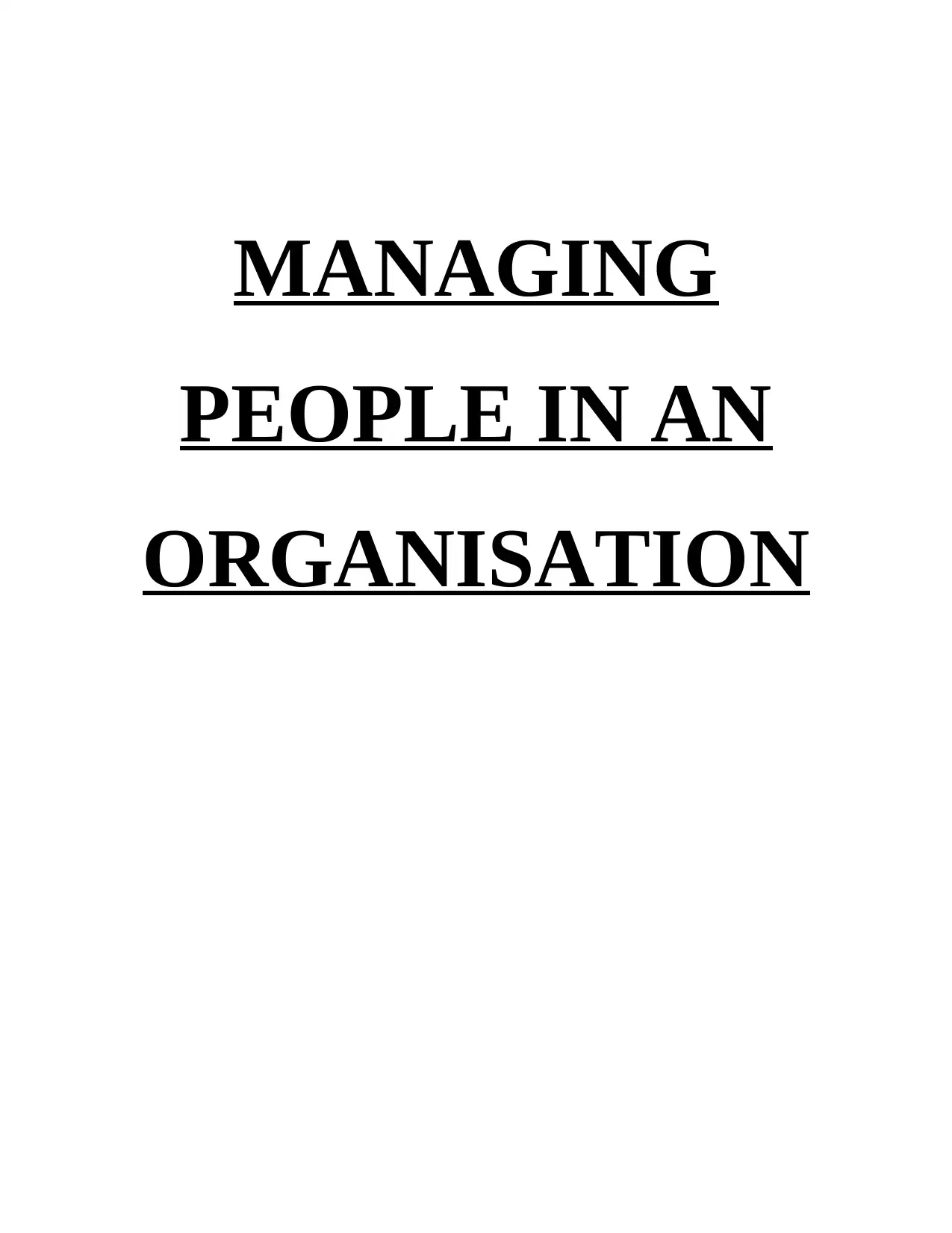
MANAGING
PEOPLE IN AN
ORGANISATION
PEOPLE IN AN
ORGANISATION
Paraphrase This Document
Need a fresh take? Get an instant paraphrase of this document with our AI Paraphraser
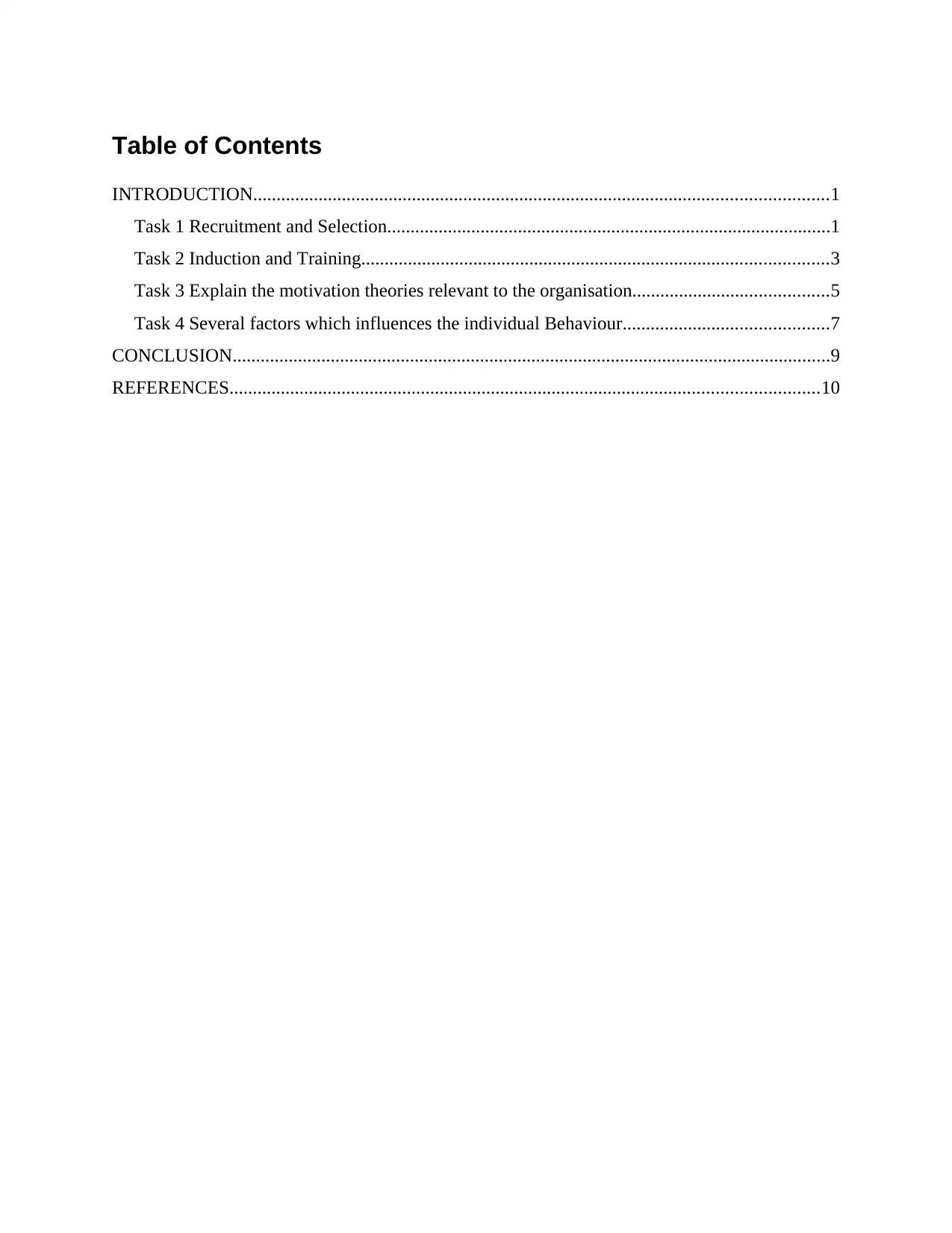
Table of Contents
INTRODUCTION...........................................................................................................................1
Task 1 Recruitment and Selection...............................................................................................1
Task 2 Induction and Training....................................................................................................3
Task 3 Explain the motivation theories relevant to the organisation..........................................5
Task 4 Several factors which influences the individual Behaviour............................................7
CONCLUSION................................................................................................................................9
REFERENCES..............................................................................................................................10
INTRODUCTION...........................................................................................................................1
Task 1 Recruitment and Selection...............................................................................................1
Task 2 Induction and Training....................................................................................................3
Task 3 Explain the motivation theories relevant to the organisation..........................................5
Task 4 Several factors which influences the individual Behaviour............................................7
CONCLUSION................................................................................................................................9
REFERENCES..............................................................................................................................10
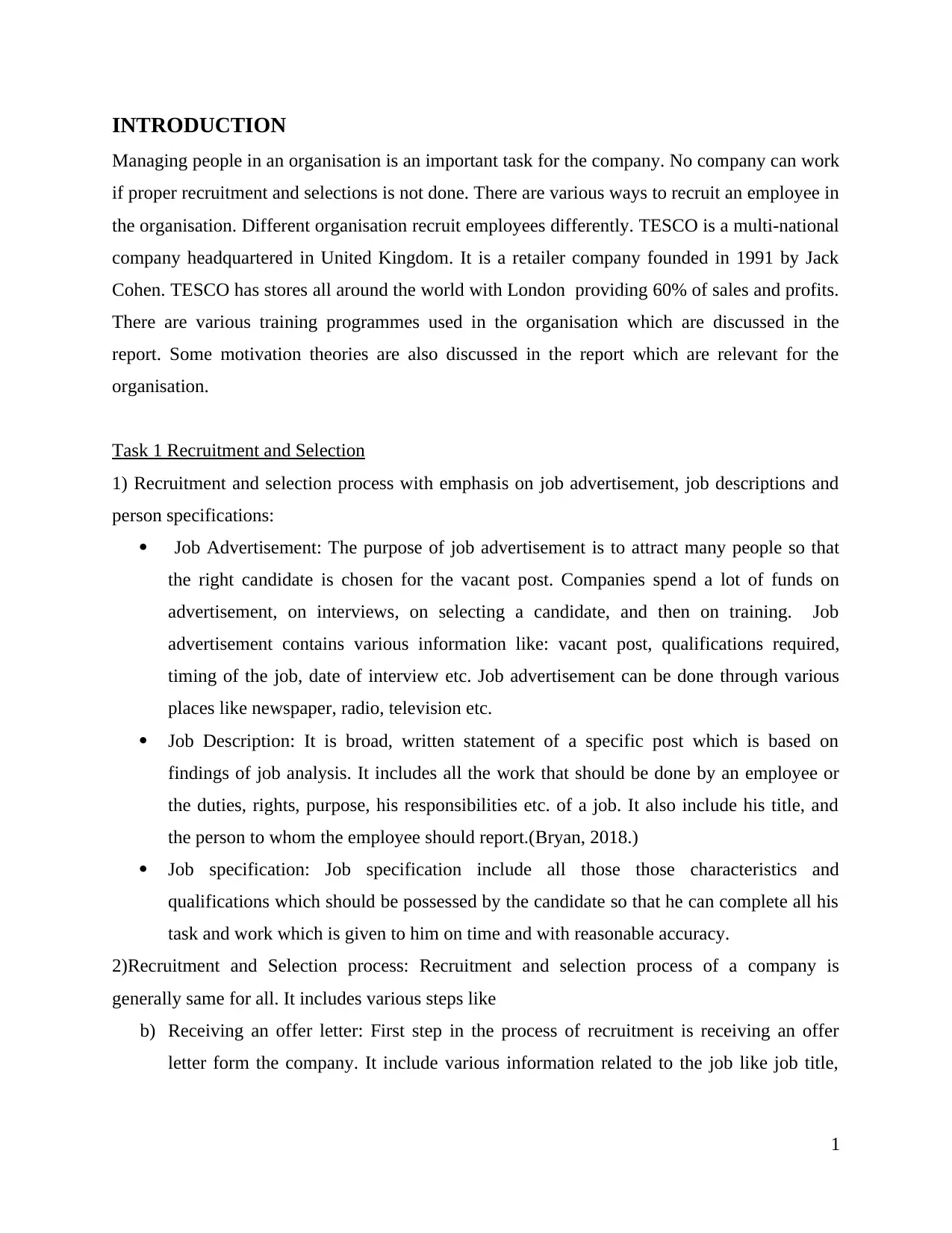
INTRODUCTION
Managing people in an organisation is an important task for the company. No company can work
if proper recruitment and selections is not done. There are various ways to recruit an employee in
the organisation. Different organisation recruit employees differently. TESCO is a multi-national
company headquartered in United Kingdom. It is a retailer company founded in 1991 by Jack
Cohen. TESCO has stores all around the world with London providing 60% of sales and profits.
There are various training programmes used in the organisation which are discussed in the
report. Some motivation theories are also discussed in the report which are relevant for the
organisation.
Task 1 Recruitment and Selection
1) Recruitment and selection process with emphasis on job advertisement, job descriptions and
person specifications:
Job Advertisement: The purpose of job advertisement is to attract many people so that
the right candidate is chosen for the vacant post. Companies spend a lot of funds on
advertisement, on interviews, on selecting a candidate, and then on training. Job
advertisement contains various information like: vacant post, qualifications required,
timing of the job, date of interview etc. Job advertisement can be done through various
places like newspaper, radio, television etc.
Job Description: It is broad, written statement of a specific post which is based on
findings of job analysis. It includes all the work that should be done by an employee or
the duties, rights, purpose, his responsibilities etc. of a job. It also include his title, and
the person to whom the employee should report.(Bryan, 2018.)
Job specification: Job specification include all those those characteristics and
qualifications which should be possessed by the candidate so that he can complete all his
task and work which is given to him on time and with reasonable accuracy.
2)Recruitment and Selection process: Recruitment and selection process of a company is
generally same for all. It includes various steps like
b) Receiving an offer letter: First step in the process of recruitment is receiving an offer
letter form the company. It include various information related to the job like job title,
1
Managing people in an organisation is an important task for the company. No company can work
if proper recruitment and selections is not done. There are various ways to recruit an employee in
the organisation. Different organisation recruit employees differently. TESCO is a multi-national
company headquartered in United Kingdom. It is a retailer company founded in 1991 by Jack
Cohen. TESCO has stores all around the world with London providing 60% of sales and profits.
There are various training programmes used in the organisation which are discussed in the
report. Some motivation theories are also discussed in the report which are relevant for the
organisation.
Task 1 Recruitment and Selection
1) Recruitment and selection process with emphasis on job advertisement, job descriptions and
person specifications:
Job Advertisement: The purpose of job advertisement is to attract many people so that
the right candidate is chosen for the vacant post. Companies spend a lot of funds on
advertisement, on interviews, on selecting a candidate, and then on training. Job
advertisement contains various information like: vacant post, qualifications required,
timing of the job, date of interview etc. Job advertisement can be done through various
places like newspaper, radio, television etc.
Job Description: It is broad, written statement of a specific post which is based on
findings of job analysis. It includes all the work that should be done by an employee or
the duties, rights, purpose, his responsibilities etc. of a job. It also include his title, and
the person to whom the employee should report.(Bryan, 2018.)
Job specification: Job specification include all those those characteristics and
qualifications which should be possessed by the candidate so that he can complete all his
task and work which is given to him on time and with reasonable accuracy.
2)Recruitment and Selection process: Recruitment and selection process of a company is
generally same for all. It includes various steps like
b) Receiving an offer letter: First step in the process of recruitment is receiving an offer
letter form the company. It include various information related to the job like job title,
1
⊘ This is a preview!⊘
Do you want full access?
Subscribe today to unlock all pages.

Trusted by 1+ million students worldwide
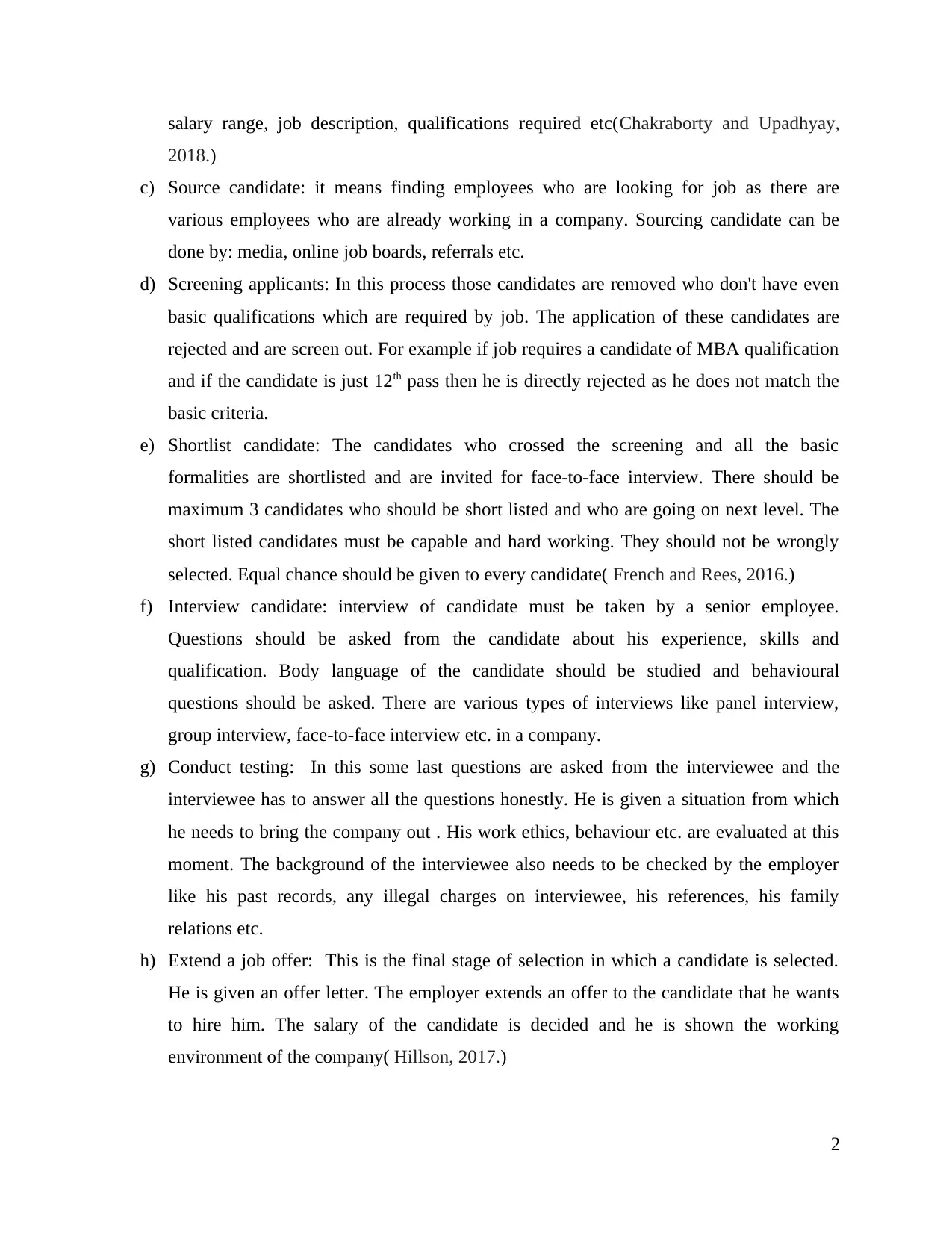
salary range, job description, qualifications required etc(Chakraborty and Upadhyay,
2018.)
c) Source candidate: it means finding employees who are looking for job as there are
various employees who are already working in a company. Sourcing candidate can be
done by: media, online job boards, referrals etc.
d) Screening applicants: In this process those candidates are removed who don't have even
basic qualifications which are required by job. The application of these candidates are
rejected and are screen out. For example if job requires a candidate of MBA qualification
and if the candidate is just 12th pass then he is directly rejected as he does not match the
basic criteria.
e) Shortlist candidate: The candidates who crossed the screening and all the basic
formalities are shortlisted and are invited for face-to-face interview. There should be
maximum 3 candidates who should be short listed and who are going on next level. The
short listed candidates must be capable and hard working. They should not be wrongly
selected. Equal chance should be given to every candidate( French and Rees, 2016.)
f) Interview candidate: interview of candidate must be taken by a senior employee.
Questions should be asked from the candidate about his experience, skills and
qualification. Body language of the candidate should be studied and behavioural
questions should be asked. There are various types of interviews like panel interview,
group interview, face-to-face interview etc. in a company.
g) Conduct testing: In this some last questions are asked from the interviewee and the
interviewee has to answer all the questions honestly. He is given a situation from which
he needs to bring the company out . His work ethics, behaviour etc. are evaluated at this
moment. The background of the interviewee also needs to be checked by the employer
like his past records, any illegal charges on interviewee, his references, his family
relations etc.
h) Extend a job offer: This is the final stage of selection in which a candidate is selected.
He is given an offer letter. The employer extends an offer to the candidate that he wants
to hire him. The salary of the candidate is decided and he is shown the working
environment of the company( Hillson, 2017.)
2
2018.)
c) Source candidate: it means finding employees who are looking for job as there are
various employees who are already working in a company. Sourcing candidate can be
done by: media, online job boards, referrals etc.
d) Screening applicants: In this process those candidates are removed who don't have even
basic qualifications which are required by job. The application of these candidates are
rejected and are screen out. For example if job requires a candidate of MBA qualification
and if the candidate is just 12th pass then he is directly rejected as he does not match the
basic criteria.
e) Shortlist candidate: The candidates who crossed the screening and all the basic
formalities are shortlisted and are invited for face-to-face interview. There should be
maximum 3 candidates who should be short listed and who are going on next level. The
short listed candidates must be capable and hard working. They should not be wrongly
selected. Equal chance should be given to every candidate( French and Rees, 2016.)
f) Interview candidate: interview of candidate must be taken by a senior employee.
Questions should be asked from the candidate about his experience, skills and
qualification. Body language of the candidate should be studied and behavioural
questions should be asked. There are various types of interviews like panel interview,
group interview, face-to-face interview etc. in a company.
g) Conduct testing: In this some last questions are asked from the interviewee and the
interviewee has to answer all the questions honestly. He is given a situation from which
he needs to bring the company out . His work ethics, behaviour etc. are evaluated at this
moment. The background of the interviewee also needs to be checked by the employer
like his past records, any illegal charges on interviewee, his references, his family
relations etc.
h) Extend a job offer: This is the final stage of selection in which a candidate is selected.
He is given an offer letter. The employer extends an offer to the candidate that he wants
to hire him. The salary of the candidate is decided and he is shown the working
environment of the company( Hillson, 2017.)
2
Paraphrase This Document
Need a fresh take? Get an instant paraphrase of this document with our AI Paraphraser
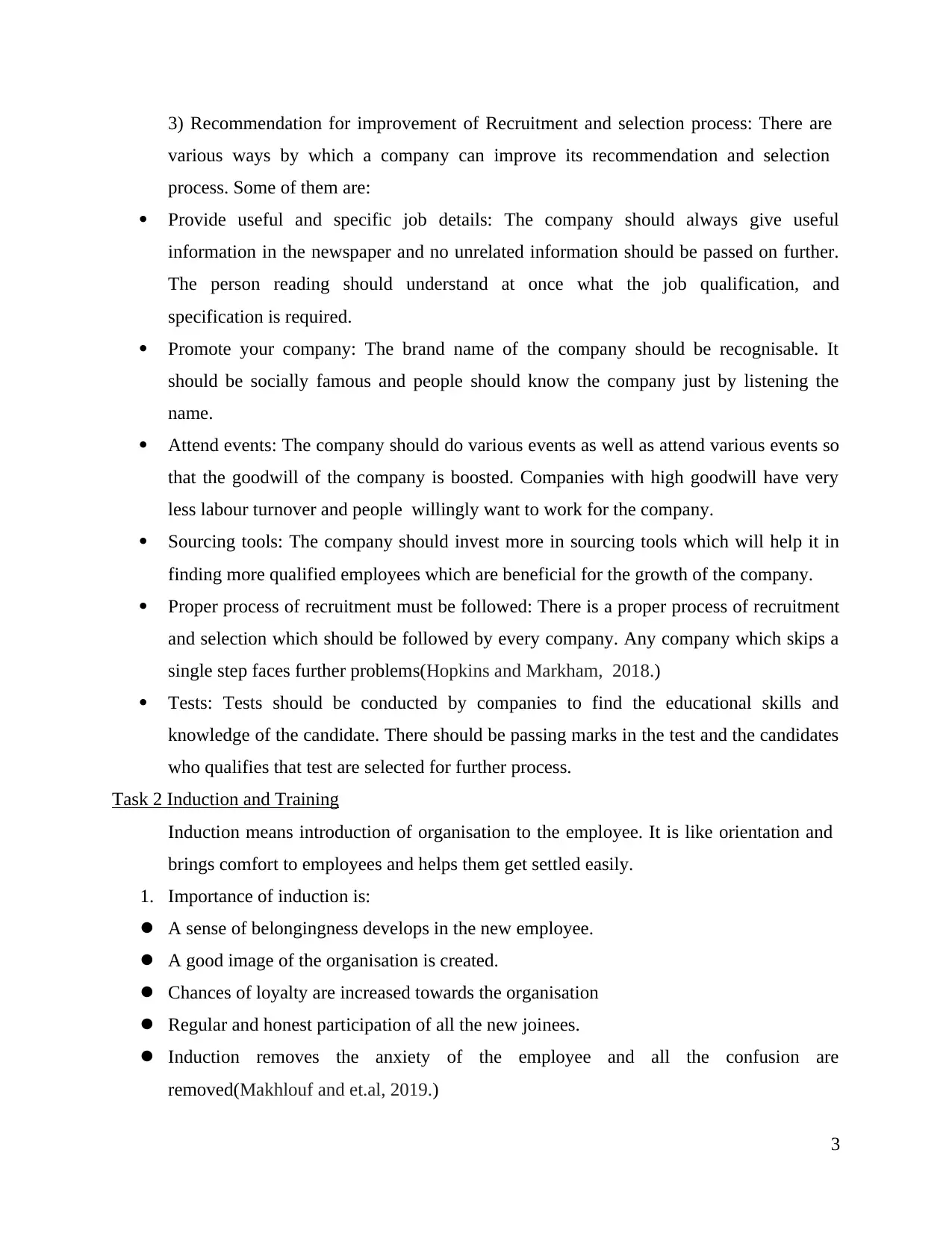
3) Recommendation for improvement of Recruitment and selection process: There are
various ways by which a company can improve its recommendation and selection
process. Some of them are:
Provide useful and specific job details: The company should always give useful
information in the newspaper and no unrelated information should be passed on further.
The person reading should understand at once what the job qualification, and
specification is required.
Promote your company: The brand name of the company should be recognisable. It
should be socially famous and people should know the company just by listening the
name.
Attend events: The company should do various events as well as attend various events so
that the goodwill of the company is boosted. Companies with high goodwill have very
less labour turnover and people willingly want to work for the company.
Sourcing tools: The company should invest more in sourcing tools which will help it in
finding more qualified employees which are beneficial for the growth of the company.
Proper process of recruitment must be followed: There is a proper process of recruitment
and selection which should be followed by every company. Any company which skips a
single step faces further problems(Hopkins and Markham, 2018.)
Tests: Tests should be conducted by companies to find the educational skills and
knowledge of the candidate. There should be passing marks in the test and the candidates
who qualifies that test are selected for further process.
Task 2 Induction and Training
Induction means introduction of organisation to the employee. It is like orientation and
brings comfort to employees and helps them get settled easily.
1. Importance of induction is:
A sense of belongingness develops in the new employee.
A good image of the organisation is created.
Chances of loyalty are increased towards the organisation
Regular and honest participation of all the new joinees.
Induction removes the anxiety of the employee and all the confusion are
removed(Makhlouf and et.al, 2019.)
3
various ways by which a company can improve its recommendation and selection
process. Some of them are:
Provide useful and specific job details: The company should always give useful
information in the newspaper and no unrelated information should be passed on further.
The person reading should understand at once what the job qualification, and
specification is required.
Promote your company: The brand name of the company should be recognisable. It
should be socially famous and people should know the company just by listening the
name.
Attend events: The company should do various events as well as attend various events so
that the goodwill of the company is boosted. Companies with high goodwill have very
less labour turnover and people willingly want to work for the company.
Sourcing tools: The company should invest more in sourcing tools which will help it in
finding more qualified employees which are beneficial for the growth of the company.
Proper process of recruitment must be followed: There is a proper process of recruitment
and selection which should be followed by every company. Any company which skips a
single step faces further problems(Hopkins and Markham, 2018.)
Tests: Tests should be conducted by companies to find the educational skills and
knowledge of the candidate. There should be passing marks in the test and the candidates
who qualifies that test are selected for further process.
Task 2 Induction and Training
Induction means introduction of organisation to the employee. It is like orientation and
brings comfort to employees and helps them get settled easily.
1. Importance of induction is:
A sense of belongingness develops in the new employee.
A good image of the organisation is created.
Chances of loyalty are increased towards the organisation
Regular and honest participation of all the new joinees.
Induction removes the anxiety of the employee and all the confusion are
removed(Makhlouf and et.al, 2019.)
3
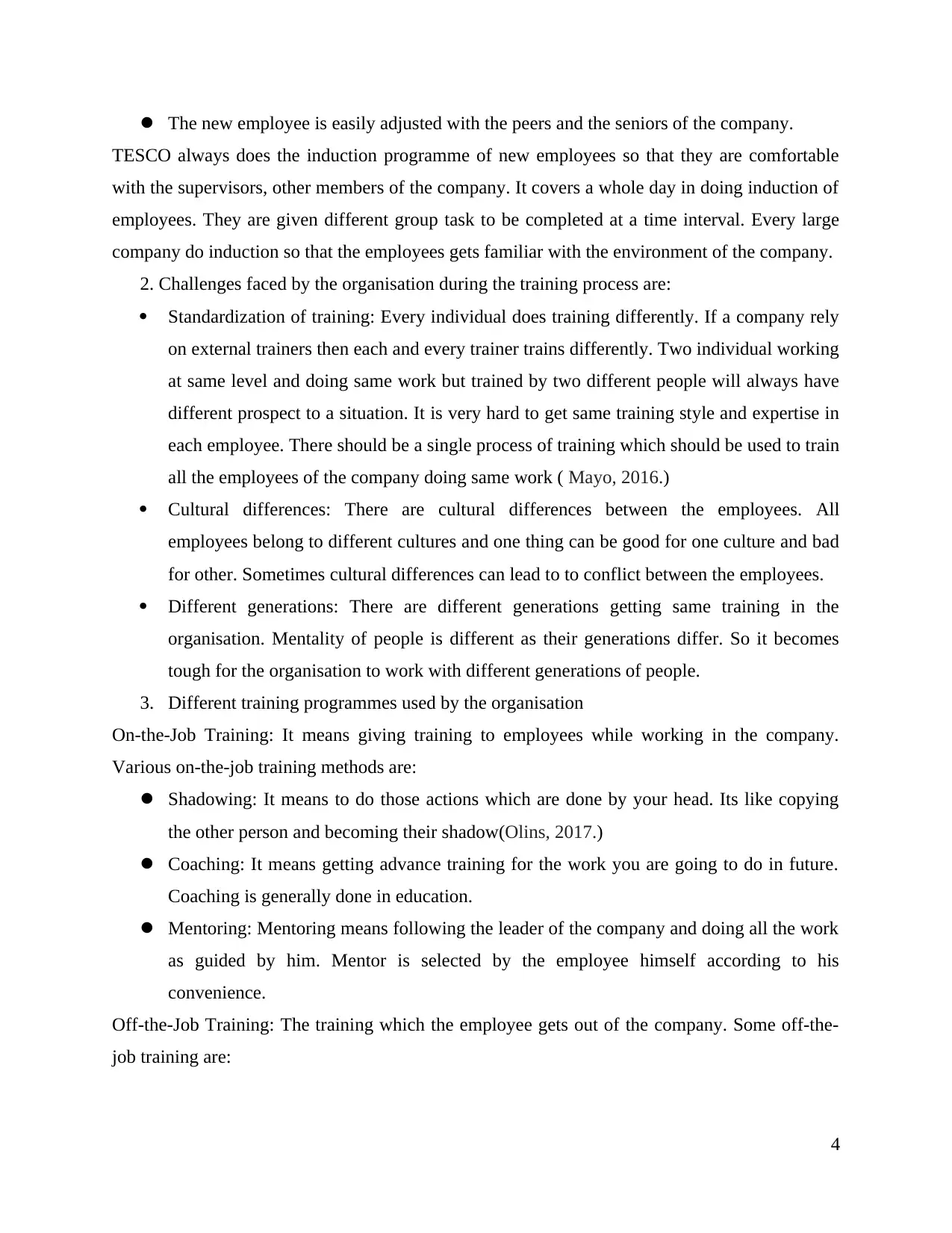
The new employee is easily adjusted with the peers and the seniors of the company.
TESCO always does the induction programme of new employees so that they are comfortable
with the supervisors, other members of the company. It covers a whole day in doing induction of
employees. They are given different group task to be completed at a time interval. Every large
company do induction so that the employees gets familiar with the environment of the company.
2. Challenges faced by the organisation during the training process are:
Standardization of training: Every individual does training differently. If a company rely
on external trainers then each and every trainer trains differently. Two individual working
at same level and doing same work but trained by two different people will always have
different prospect to a situation. It is very hard to get same training style and expertise in
each employee. There should be a single process of training which should be used to train
all the employees of the company doing same work ( Mayo, 2016.)
Cultural differences: There are cultural differences between the employees. All
employees belong to different cultures and one thing can be good for one culture and bad
for other. Sometimes cultural differences can lead to to conflict between the employees.
Different generations: There are different generations getting same training in the
organisation. Mentality of people is different as their generations differ. So it becomes
tough for the organisation to work with different generations of people.
3. Different training programmes used by the organisation
On-the-Job Training: It means giving training to employees while working in the company.
Various on-the-job training methods are:
Shadowing: It means to do those actions which are done by your head. Its like copying
the other person and becoming their shadow(Olins, 2017.)
Coaching: It means getting advance training for the work you are going to do in future.
Coaching is generally done in education.
Mentoring: Mentoring means following the leader of the company and doing all the work
as guided by him. Mentor is selected by the employee himself according to his
convenience.
Off-the-Job Training: The training which the employee gets out of the company. Some off-the-
job training are:
4
TESCO always does the induction programme of new employees so that they are comfortable
with the supervisors, other members of the company. It covers a whole day in doing induction of
employees. They are given different group task to be completed at a time interval. Every large
company do induction so that the employees gets familiar with the environment of the company.
2. Challenges faced by the organisation during the training process are:
Standardization of training: Every individual does training differently. If a company rely
on external trainers then each and every trainer trains differently. Two individual working
at same level and doing same work but trained by two different people will always have
different prospect to a situation. It is very hard to get same training style and expertise in
each employee. There should be a single process of training which should be used to train
all the employees of the company doing same work ( Mayo, 2016.)
Cultural differences: There are cultural differences between the employees. All
employees belong to different cultures and one thing can be good for one culture and bad
for other. Sometimes cultural differences can lead to to conflict between the employees.
Different generations: There are different generations getting same training in the
organisation. Mentality of people is different as their generations differ. So it becomes
tough for the organisation to work with different generations of people.
3. Different training programmes used by the organisation
On-the-Job Training: It means giving training to employees while working in the company.
Various on-the-job training methods are:
Shadowing: It means to do those actions which are done by your head. Its like copying
the other person and becoming their shadow(Olins, 2017.)
Coaching: It means getting advance training for the work you are going to do in future.
Coaching is generally done in education.
Mentoring: Mentoring means following the leader of the company and doing all the work
as guided by him. Mentor is selected by the employee himself according to his
convenience.
Off-the-Job Training: The training which the employee gets out of the company. Some off-the-
job training are:
4
⊘ This is a preview!⊘
Do you want full access?
Subscribe today to unlock all pages.

Trusted by 1+ million students worldwide
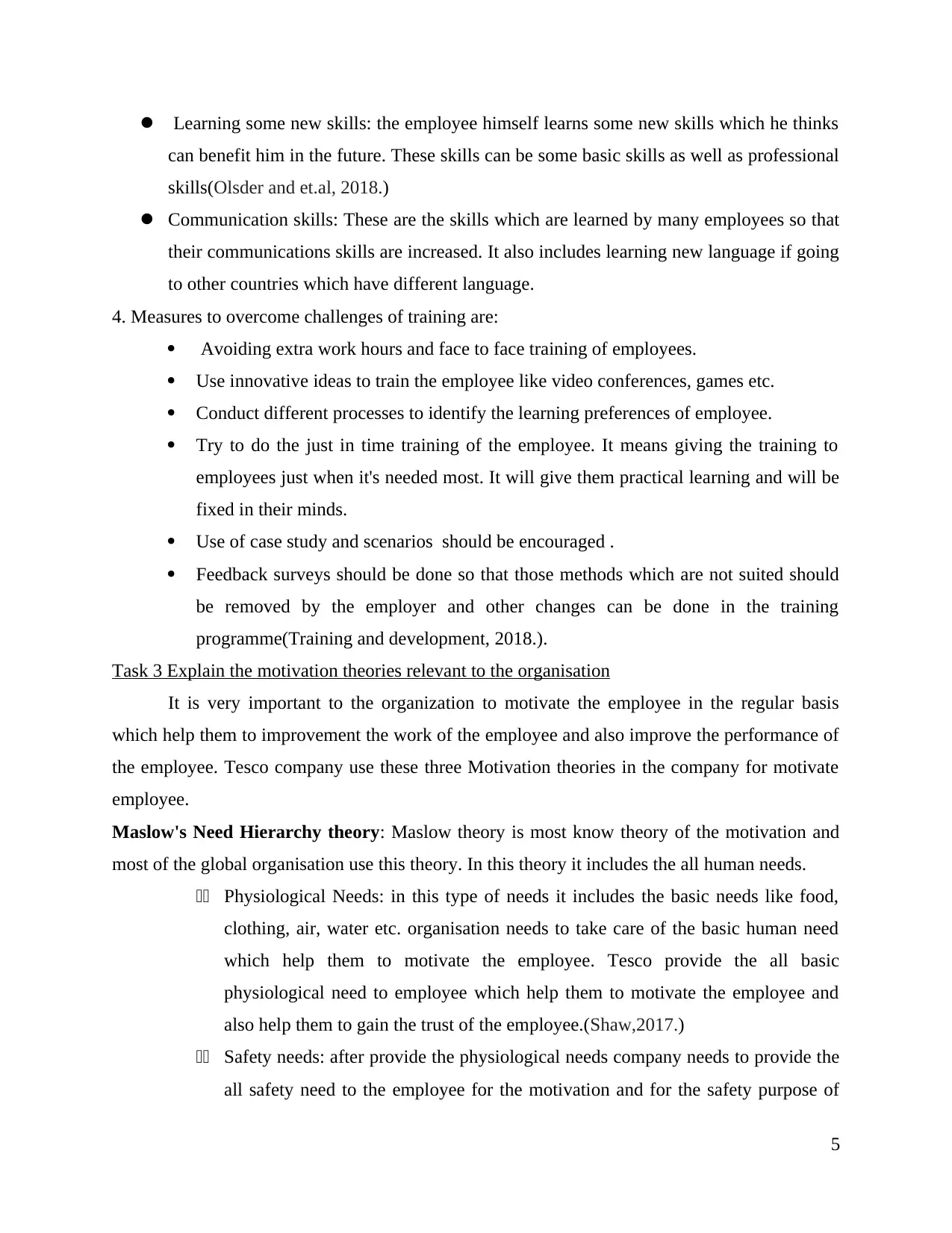
Learning some new skills: the employee himself learns some new skills which he thinks
can benefit him in the future. These skills can be some basic skills as well as professional
skills(Olsder and et.al, 2018.)
Communication skills: These are the skills which are learned by many employees so that
their communications skills are increased. It also includes learning new language if going
to other countries which have different language.
4. Measures to overcome challenges of training are:
Avoiding extra work hours and face to face training of employees.
Use innovative ideas to train the employee like video conferences, games etc.
Conduct different processes to identify the learning preferences of employee.
Try to do the just in time training of the employee. It means giving the training to
employees just when it's needed most. It will give them practical learning and will be
fixed in their minds.
Use of case study and scenarios should be encouraged .
Feedback surveys should be done so that those methods which are not suited should
be removed by the employer and other changes can be done in the training
programme(Training and development, 2018.).
Task 3 Explain the motivation theories relevant to the organisation
It is very important to the organization to motivate the employee in the regular basis
which help them to improvement the work of the employee and also improve the performance of
the employee. Tesco company use these three Motivation theories in the company for motivate
employee.
Maslow's Need Hierarchy theory: Maslow theory is most know theory of the motivation and
most of the global organisation use this theory. In this theory it includes the all human needs.
11 Physiological Needs: in this type of needs it includes the basic needs like food,
clothing, air, water etc. organisation needs to take care of the basic human need
which help them to motivate the employee. Tesco provide the all basic
physiological need to employee which help them to motivate the employee and
also help them to gain the trust of the employee.(Shaw,2017.)
11 Safety needs: after provide the physiological needs company needs to provide the
all safety need to the employee for the motivation and for the safety purpose of
5
can benefit him in the future. These skills can be some basic skills as well as professional
skills(Olsder and et.al, 2018.)
Communication skills: These are the skills which are learned by many employees so that
their communications skills are increased. It also includes learning new language if going
to other countries which have different language.
4. Measures to overcome challenges of training are:
Avoiding extra work hours and face to face training of employees.
Use innovative ideas to train the employee like video conferences, games etc.
Conduct different processes to identify the learning preferences of employee.
Try to do the just in time training of the employee. It means giving the training to
employees just when it's needed most. It will give them practical learning and will be
fixed in their minds.
Use of case study and scenarios should be encouraged .
Feedback surveys should be done so that those methods which are not suited should
be removed by the employer and other changes can be done in the training
programme(Training and development, 2018.).
Task 3 Explain the motivation theories relevant to the organisation
It is very important to the organization to motivate the employee in the regular basis
which help them to improvement the work of the employee and also improve the performance of
the employee. Tesco company use these three Motivation theories in the company for motivate
employee.
Maslow's Need Hierarchy theory: Maslow theory is most know theory of the motivation and
most of the global organisation use this theory. In this theory it includes the all human needs.
11 Physiological Needs: in this type of needs it includes the basic needs like food,
clothing, air, water etc. organisation needs to take care of the basic human need
which help them to motivate the employee. Tesco provide the all basic
physiological need to employee which help them to motivate the employee and
also help them to gain the trust of the employee.(Shaw,2017.)
11 Safety needs: after provide the physiological needs company needs to provide the
all safety need to the employee for the motivation and for the safety purpose of
5
Paraphrase This Document
Need a fresh take? Get an instant paraphrase of this document with our AI Paraphraser
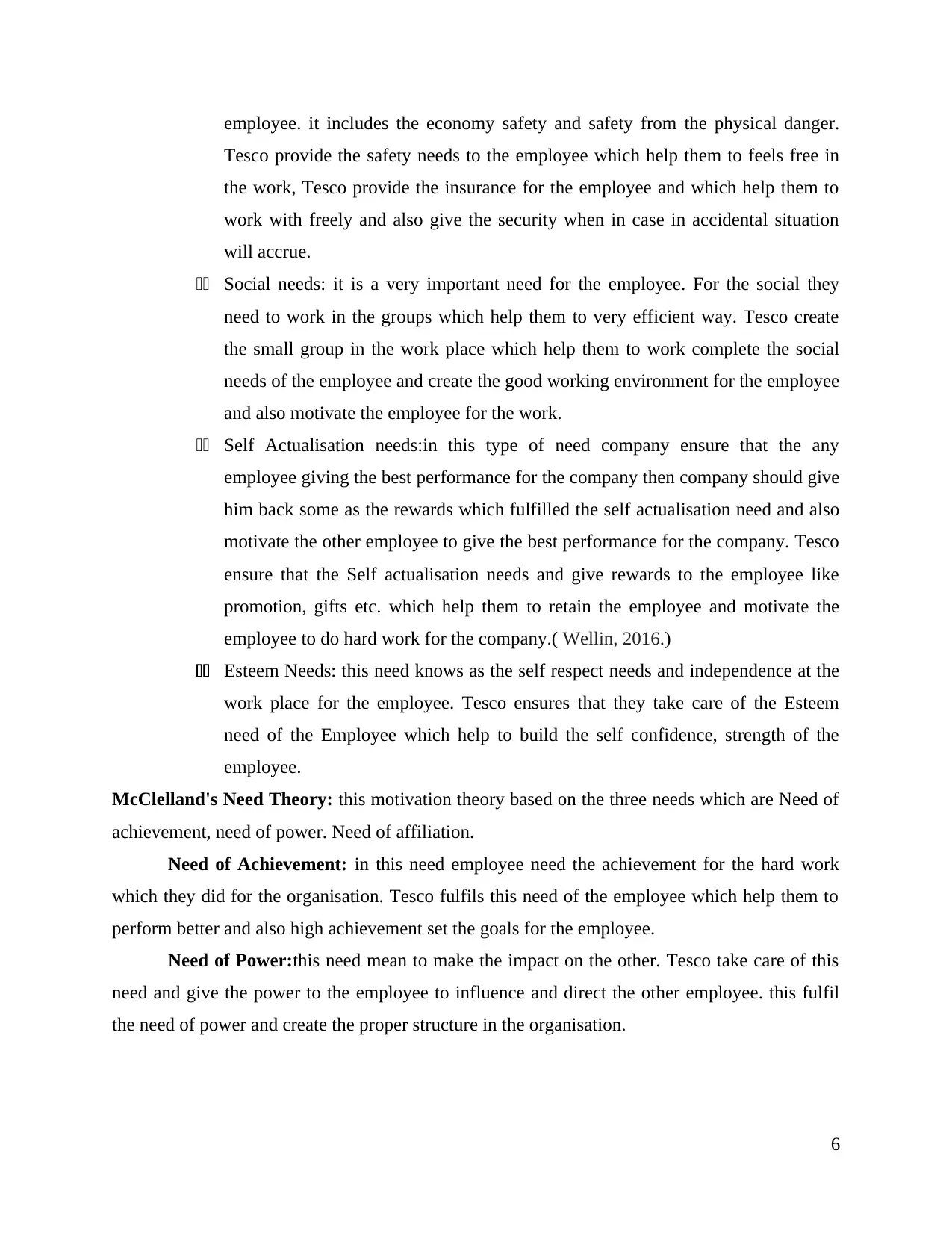
employee. it includes the economy safety and safety from the physical danger.
Tesco provide the safety needs to the employee which help them to feels free in
the work, Tesco provide the insurance for the employee and which help them to
work with freely and also give the security when in case in accidental situation
will accrue.
11 Social needs: it is a very important need for the employee. For the social they
need to work in the groups which help them to very efficient way. Tesco create
the small group in the work place which help them to work complete the social
needs of the employee and create the good working environment for the employee
and also motivate the employee for the work.
11 Self Actualisation needs:in this type of need company ensure that the any
employee giving the best performance for the company then company should give
him back some as the rewards which fulfilled the self actualisation need and also
motivate the other employee to give the best performance for the company. Tesco
ensure that the Self actualisation needs and give rewards to the employee like
promotion, gifts etc. which help them to retain the employee and motivate the
employee to do hard work for the company.( Wellin, 2016.)
11 Esteem Needs: this need knows as the self respect needs and independence at the
work place for the employee. Tesco ensures that they take care of the Esteem
need of the Employee which help to build the self confidence, strength of the
employee.
McClelland's Need Theory: this motivation theory based on the three needs which are Need of
achievement, need of power. Need of affiliation.
Need of Achievement: in this need employee need the achievement for the hard work
which they did for the organisation. Tesco fulfils this need of the employee which help them to
perform better and also high achievement set the goals for the employee.
Need of Power:this need mean to make the impact on the other. Tesco take care of this
need and give the power to the employee to influence and direct the other employee. this fulfil
the need of power and create the proper structure in the organisation.
6
Tesco provide the safety needs to the employee which help them to feels free in
the work, Tesco provide the insurance for the employee and which help them to
work with freely and also give the security when in case in accidental situation
will accrue.
11 Social needs: it is a very important need for the employee. For the social they
need to work in the groups which help them to very efficient way. Tesco create
the small group in the work place which help them to work complete the social
needs of the employee and create the good working environment for the employee
and also motivate the employee for the work.
11 Self Actualisation needs:in this type of need company ensure that the any
employee giving the best performance for the company then company should give
him back some as the rewards which fulfilled the self actualisation need and also
motivate the other employee to give the best performance for the company. Tesco
ensure that the Self actualisation needs and give rewards to the employee like
promotion, gifts etc. which help them to retain the employee and motivate the
employee to do hard work for the company.( Wellin, 2016.)
11 Esteem Needs: this need knows as the self respect needs and independence at the
work place for the employee. Tesco ensures that they take care of the Esteem
need of the Employee which help to build the self confidence, strength of the
employee.
McClelland's Need Theory: this motivation theory based on the three needs which are Need of
achievement, need of power. Need of affiliation.
Need of Achievement: in this need employee need the achievement for the hard work
which they did for the organisation. Tesco fulfils this need of the employee which help them to
perform better and also high achievement set the goals for the employee.
Need of Power:this need mean to make the impact on the other. Tesco take care of this
need and give the power to the employee to influence and direct the other employee. this fulfil
the need of power and create the proper structure in the organisation.
6
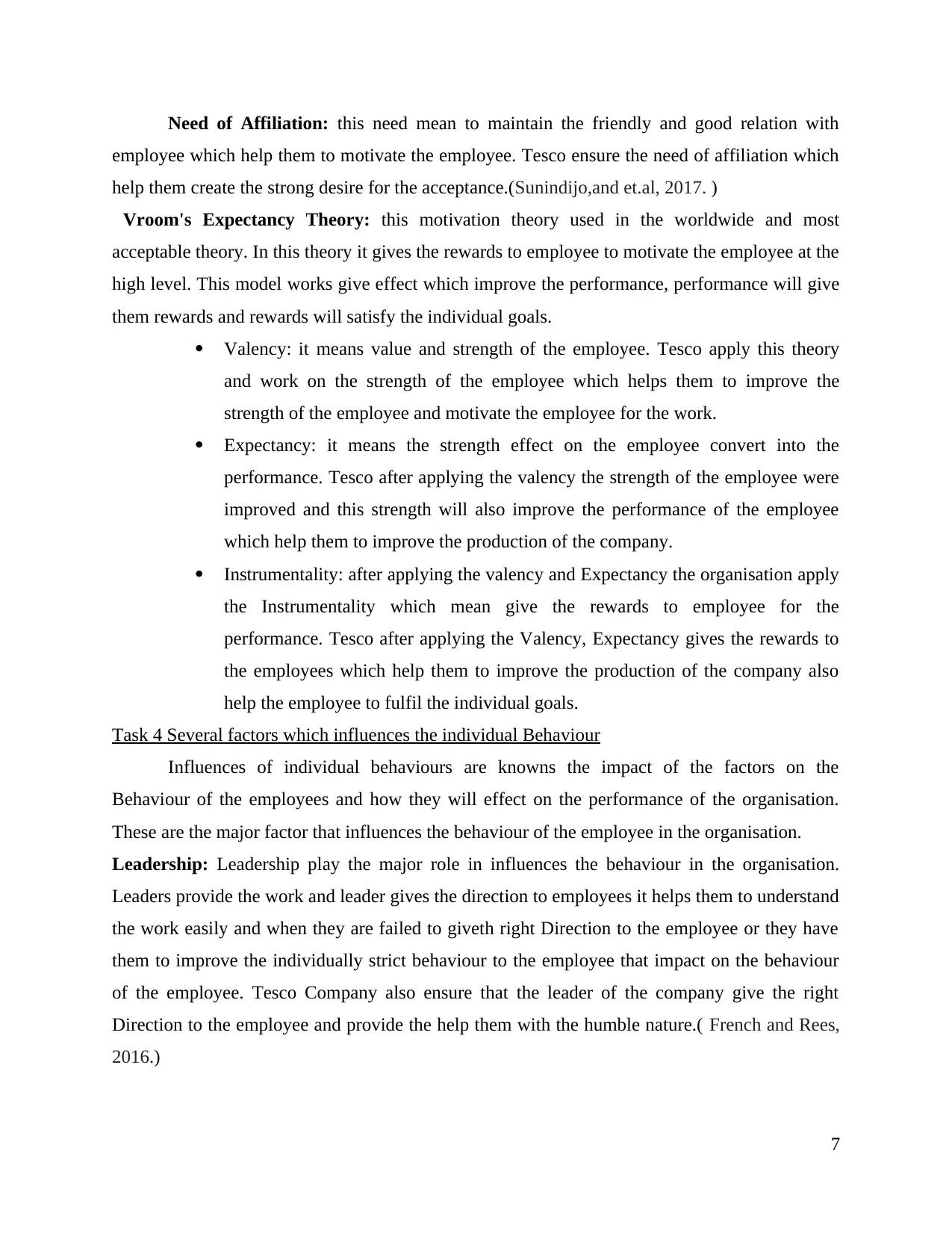
Need of Affiliation: this need mean to maintain the friendly and good relation with
employee which help them to motivate the employee. Tesco ensure the need of affiliation which
help them create the strong desire for the acceptance.(Sunindijo,and et.al, 2017. )
Vroom's Expectancy Theory: this motivation theory used in the worldwide and most
acceptable theory. In this theory it gives the rewards to employee to motivate the employee at the
high level. This model works give effect which improve the performance, performance will give
them rewards and rewards will satisfy the individual goals.
Valency: it means value and strength of the employee. Tesco apply this theory
and work on the strength of the employee which helps them to improve the
strength of the employee and motivate the employee for the work.
Expectancy: it means the strength effect on the employee convert into the
performance. Tesco after applying the valency the strength of the employee were
improved and this strength will also improve the performance of the employee
which help them to improve the production of the company.
Instrumentality: after applying the valency and Expectancy the organisation apply
the Instrumentality which mean give the rewards to employee for the
performance. Tesco after applying the Valency, Expectancy gives the rewards to
the employees which help them to improve the production of the company also
help the employee to fulfil the individual goals.
Task 4 Several factors which influences the individual Behaviour
Influences of individual behaviours are knowns the impact of the factors on the
Behaviour of the employees and how they will effect on the performance of the organisation.
These are the major factor that influences the behaviour of the employee in the organisation.
Leadership: Leadership play the major role in influences the behaviour in the organisation.
Leaders provide the work and leader gives the direction to employees it helps them to understand
the work easily and when they are failed to giveth right Direction to the employee or they have
them to improve the individually strict behaviour to the employee that impact on the behaviour
of the employee. Tesco Company also ensure that the leader of the company give the right
Direction to the employee and provide the help them with the humble nature.( French and Rees,
2016.)
7
employee which help them to motivate the employee. Tesco ensure the need of affiliation which
help them create the strong desire for the acceptance.(Sunindijo,and et.al, 2017. )
Vroom's Expectancy Theory: this motivation theory used in the worldwide and most
acceptable theory. In this theory it gives the rewards to employee to motivate the employee at the
high level. This model works give effect which improve the performance, performance will give
them rewards and rewards will satisfy the individual goals.
Valency: it means value and strength of the employee. Tesco apply this theory
and work on the strength of the employee which helps them to improve the
strength of the employee and motivate the employee for the work.
Expectancy: it means the strength effect on the employee convert into the
performance. Tesco after applying the valency the strength of the employee were
improved and this strength will also improve the performance of the employee
which help them to improve the production of the company.
Instrumentality: after applying the valency and Expectancy the organisation apply
the Instrumentality which mean give the rewards to employee for the
performance. Tesco after applying the Valency, Expectancy gives the rewards to
the employees which help them to improve the production of the company also
help the employee to fulfil the individual goals.
Task 4 Several factors which influences the individual Behaviour
Influences of individual behaviours are knowns the impact of the factors on the
Behaviour of the employees and how they will effect on the performance of the organisation.
These are the major factor that influences the behaviour of the employee in the organisation.
Leadership: Leadership play the major role in influences the behaviour in the organisation.
Leaders provide the work and leader gives the direction to employees it helps them to understand
the work easily and when they are failed to giveth right Direction to the employee or they have
them to improve the individually strict behaviour to the employee that impact on the behaviour
of the employee. Tesco Company also ensure that the leader of the company give the right
Direction to the employee and provide the help them with the humble nature.( French and Rees,
2016.)
7
⊘ This is a preview!⊘
Do you want full access?
Subscribe today to unlock all pages.

Trusted by 1+ million students worldwide
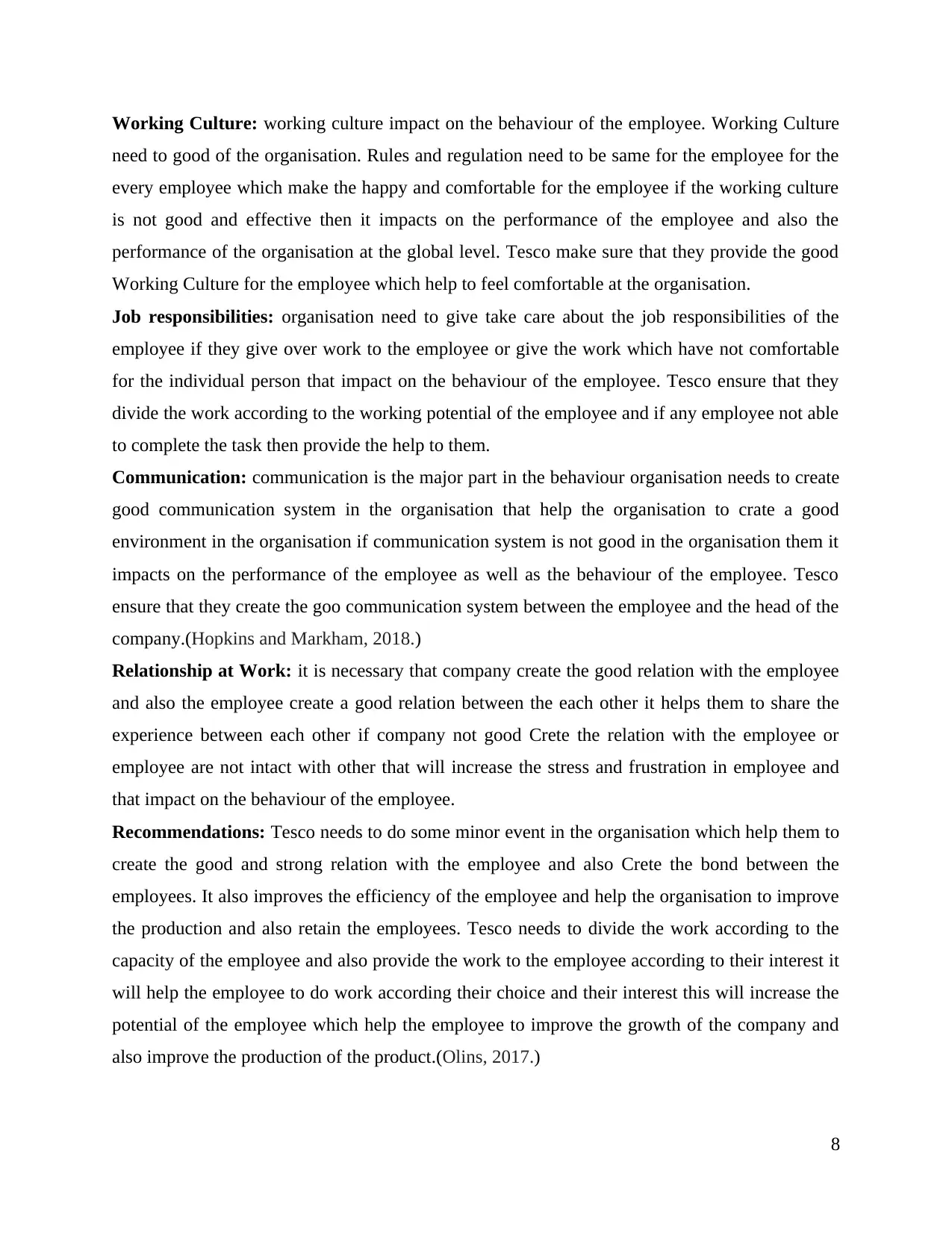
Working Culture: working culture impact on the behaviour of the employee. Working Culture
need to good of the organisation. Rules and regulation need to be same for the employee for the
every employee which make the happy and comfortable for the employee if the working culture
is not good and effective then it impacts on the performance of the employee and also the
performance of the organisation at the global level. Tesco make sure that they provide the good
Working Culture for the employee which help to feel comfortable at the organisation.
Job responsibilities: organisation need to give take care about the job responsibilities of the
employee if they give over work to the employee or give the work which have not comfortable
for the individual person that impact on the behaviour of the employee. Tesco ensure that they
divide the work according to the working potential of the employee and if any employee not able
to complete the task then provide the help to them.
Communication: communication is the major part in the behaviour organisation needs to create
good communication system in the organisation that help the organisation to crate a good
environment in the organisation if communication system is not good in the organisation them it
impacts on the performance of the employee as well as the behaviour of the employee. Tesco
ensure that they create the goo communication system between the employee and the head of the
company.(Hopkins and Markham, 2018.)
Relationship at Work: it is necessary that company create the good relation with the employee
and also the employee create a good relation between the each other it helps them to share the
experience between each other if company not good Crete the relation with the employee or
employee are not intact with other that will increase the stress and frustration in employee and
that impact on the behaviour of the employee.
Recommendations: Tesco needs to do some minor event in the organisation which help them to
create the good and strong relation with the employee and also Crete the bond between the
employees. It also improves the efficiency of the employee and help the organisation to improve
the production and also retain the employees. Tesco needs to divide the work according to the
capacity of the employee and also provide the work to the employee according to their interest it
will help the employee to do work according their choice and their interest this will increase the
potential of the employee which help the employee to improve the growth of the company and
also improve the production of the product.(Olins, 2017.)
8
need to good of the organisation. Rules and regulation need to be same for the employee for the
every employee which make the happy and comfortable for the employee if the working culture
is not good and effective then it impacts on the performance of the employee and also the
performance of the organisation at the global level. Tesco make sure that they provide the good
Working Culture for the employee which help to feel comfortable at the organisation.
Job responsibilities: organisation need to give take care about the job responsibilities of the
employee if they give over work to the employee or give the work which have not comfortable
for the individual person that impact on the behaviour of the employee. Tesco ensure that they
divide the work according to the working potential of the employee and if any employee not able
to complete the task then provide the help to them.
Communication: communication is the major part in the behaviour organisation needs to create
good communication system in the organisation that help the organisation to crate a good
environment in the organisation if communication system is not good in the organisation them it
impacts on the performance of the employee as well as the behaviour of the employee. Tesco
ensure that they create the goo communication system between the employee and the head of the
company.(Hopkins and Markham, 2018.)
Relationship at Work: it is necessary that company create the good relation with the employee
and also the employee create a good relation between the each other it helps them to share the
experience between each other if company not good Crete the relation with the employee or
employee are not intact with other that will increase the stress and frustration in employee and
that impact on the behaviour of the employee.
Recommendations: Tesco needs to do some minor event in the organisation which help them to
create the good and strong relation with the employee and also Crete the bond between the
employees. It also improves the efficiency of the employee and help the organisation to improve
the production and also retain the employees. Tesco needs to divide the work according to the
capacity of the employee and also provide the work to the employee according to their interest it
will help the employee to do work according their choice and their interest this will increase the
potential of the employee which help the employee to improve the growth of the company and
also improve the production of the product.(Olins, 2017.)
8
Paraphrase This Document
Need a fresh take? Get an instant paraphrase of this document with our AI Paraphraser
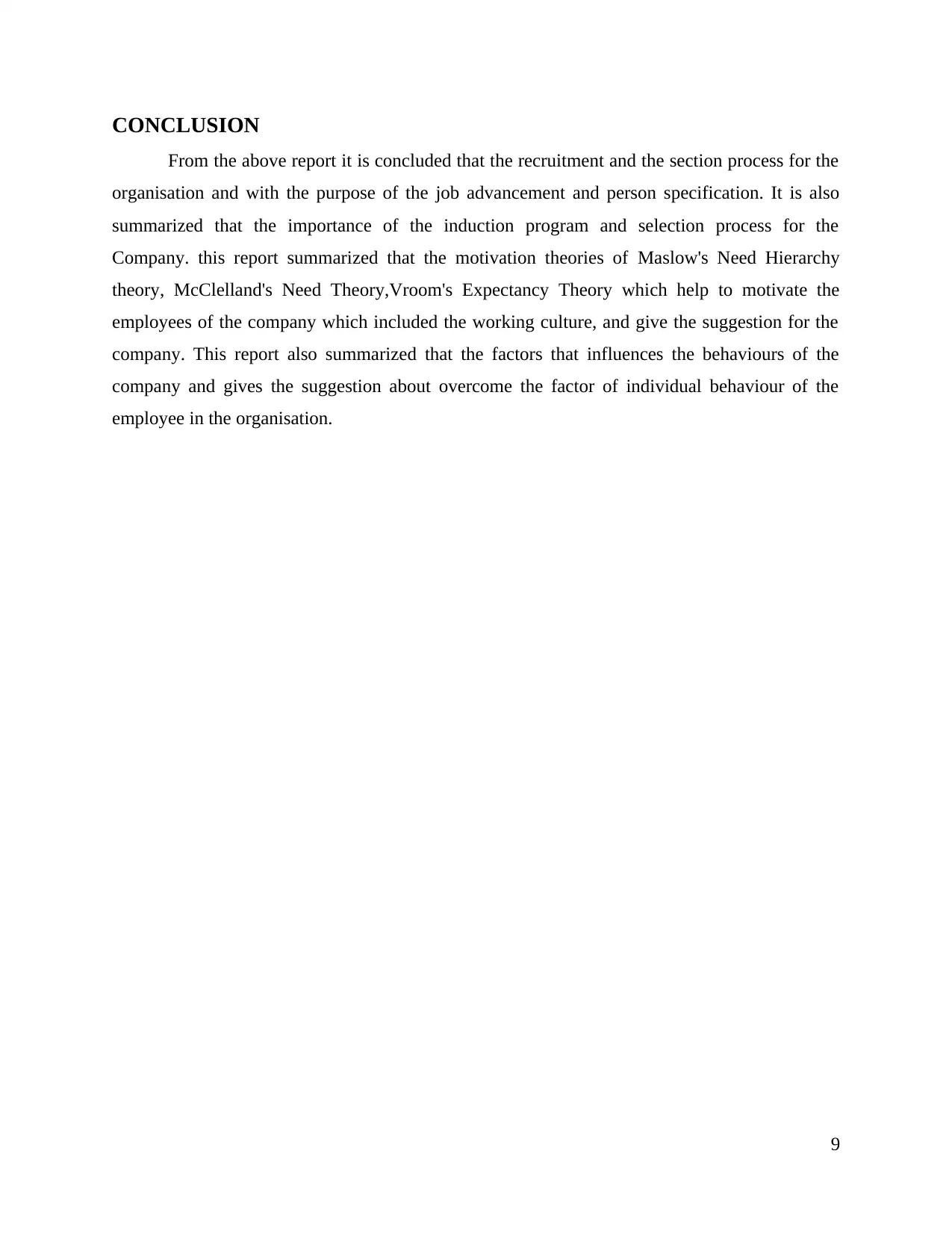
CONCLUSION
From the above report it is concluded that the recruitment and the section process for the
organisation and with the purpose of the job advancement and person specification. It is also
summarized that the importance of the induction program and selection process for the
Company. this report summarized that the motivation theories of Maslow's Need Hierarchy
theory, McClelland's Need Theory,Vroom's Expectancy Theory which help to motivate the
employees of the company which included the working culture, and give the suggestion for the
company. This report also summarized that the factors that influences the behaviours of the
company and gives the suggestion about overcome the factor of individual behaviour of the
employee in the organisation.
9
From the above report it is concluded that the recruitment and the section process for the
organisation and with the purpose of the job advancement and person specification. It is also
summarized that the importance of the induction program and selection process for the
Company. this report summarized that the motivation theories of Maslow's Need Hierarchy
theory, McClelland's Need Theory,Vroom's Expectancy Theory which help to motivate the
employees of the company which included the working culture, and give the suggestion for the
company. This report also summarized that the factors that influences the behaviours of the
company and gives the suggestion about overcome the factor of individual behaviour of the
employee in the organisation.
9
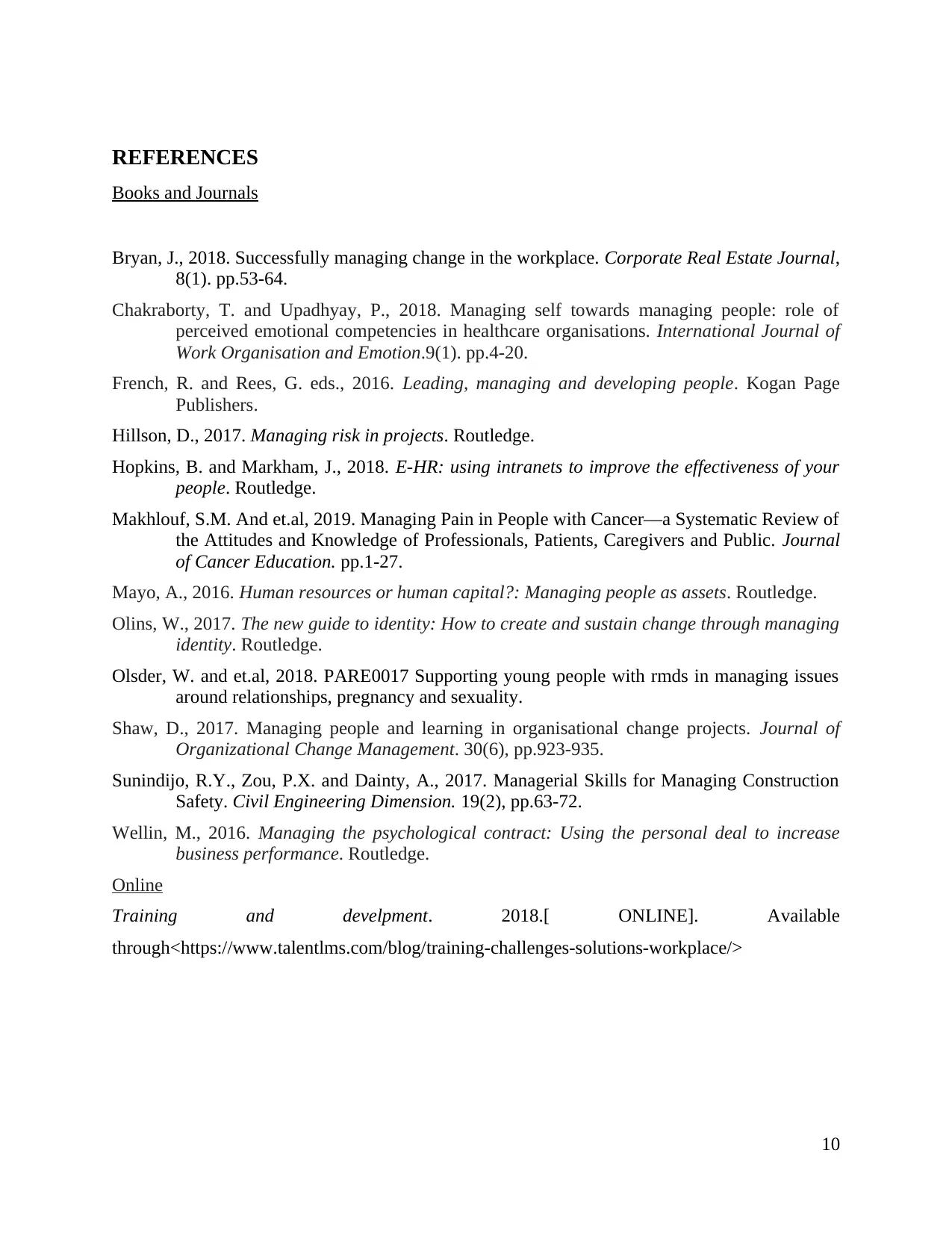
REFERENCES
Books and Journals
Bryan, J., 2018. Successfully managing change in the workplace. Corporate Real Estate Journal,
8(1). pp.53-64.
Chakraborty, T. and Upadhyay, P., 2018. Managing self towards managing people: role of
perceived emotional competencies in healthcare organisations. International Journal of
Work Organisation and Emotion.9(1). pp.4-20.
French, R. and Rees, G. eds., 2016. Leading, managing and developing people. Kogan Page
Publishers.
Hillson, D., 2017. Managing risk in projects. Routledge.
Hopkins, B. and Markham, J., 2018. E-HR: using intranets to improve the effectiveness of your
people. Routledge.
Makhlouf, S.M. And et.al, 2019. Managing Pain in People with Cancer—a Systematic Review of
the Attitudes and Knowledge of Professionals, Patients, Caregivers and Public. Journal
of Cancer Education. pp.1-27.
Mayo, A., 2016. Human resources or human capital?: Managing people as assets. Routledge.
Olins, W., 2017. The new guide to identity: How to create and sustain change through managing
identity. Routledge.
Olsder, W. and et.al, 2018. PARE0017 Supporting young people with rmds in managing issues
around relationships, pregnancy and sexuality.
Shaw, D., 2017. Managing people and learning in organisational change projects. Journal of
Organizational Change Management. 30(6), pp.923-935.
Sunindijo, R.Y., Zou, P.X. and Dainty, A., 2017. Managerial Skills for Managing Construction
Safety. Civil Engineering Dimension. 19(2), pp.63-72.
Wellin, M., 2016. Managing the psychological contract: Using the personal deal to increase
business performance. Routledge.
Online
Training and develpment. 2018.[ ONLINE]. Available
through<https://www.talentlms.com/blog/training-challenges-solutions-workplace/>
10
Books and Journals
Bryan, J., 2018. Successfully managing change in the workplace. Corporate Real Estate Journal,
8(1). pp.53-64.
Chakraborty, T. and Upadhyay, P., 2018. Managing self towards managing people: role of
perceived emotional competencies in healthcare organisations. International Journal of
Work Organisation and Emotion.9(1). pp.4-20.
French, R. and Rees, G. eds., 2016. Leading, managing and developing people. Kogan Page
Publishers.
Hillson, D., 2017. Managing risk in projects. Routledge.
Hopkins, B. and Markham, J., 2018. E-HR: using intranets to improve the effectiveness of your
people. Routledge.
Makhlouf, S.M. And et.al, 2019. Managing Pain in People with Cancer—a Systematic Review of
the Attitudes and Knowledge of Professionals, Patients, Caregivers and Public. Journal
of Cancer Education. pp.1-27.
Mayo, A., 2016. Human resources or human capital?: Managing people as assets. Routledge.
Olins, W., 2017. The new guide to identity: How to create and sustain change through managing
identity. Routledge.
Olsder, W. and et.al, 2018. PARE0017 Supporting young people with rmds in managing issues
around relationships, pregnancy and sexuality.
Shaw, D., 2017. Managing people and learning in organisational change projects. Journal of
Organizational Change Management. 30(6), pp.923-935.
Sunindijo, R.Y., Zou, P.X. and Dainty, A., 2017. Managerial Skills for Managing Construction
Safety. Civil Engineering Dimension. 19(2), pp.63-72.
Wellin, M., 2016. Managing the psychological contract: Using the personal deal to increase
business performance. Routledge.
Online
Training and develpment. 2018.[ ONLINE]. Available
through<https://www.talentlms.com/blog/training-challenges-solutions-workplace/>
10
⊘ This is a preview!⊘
Do you want full access?
Subscribe today to unlock all pages.

Trusted by 1+ million students worldwide
1 out of 12
Related Documents
Your All-in-One AI-Powered Toolkit for Academic Success.
+13062052269
info@desklib.com
Available 24*7 on WhatsApp / Email
![[object Object]](/_next/static/media/star-bottom.7253800d.svg)
Unlock your academic potential
Copyright © 2020–2025 A2Z Services. All Rights Reserved. Developed and managed by ZUCOL.



